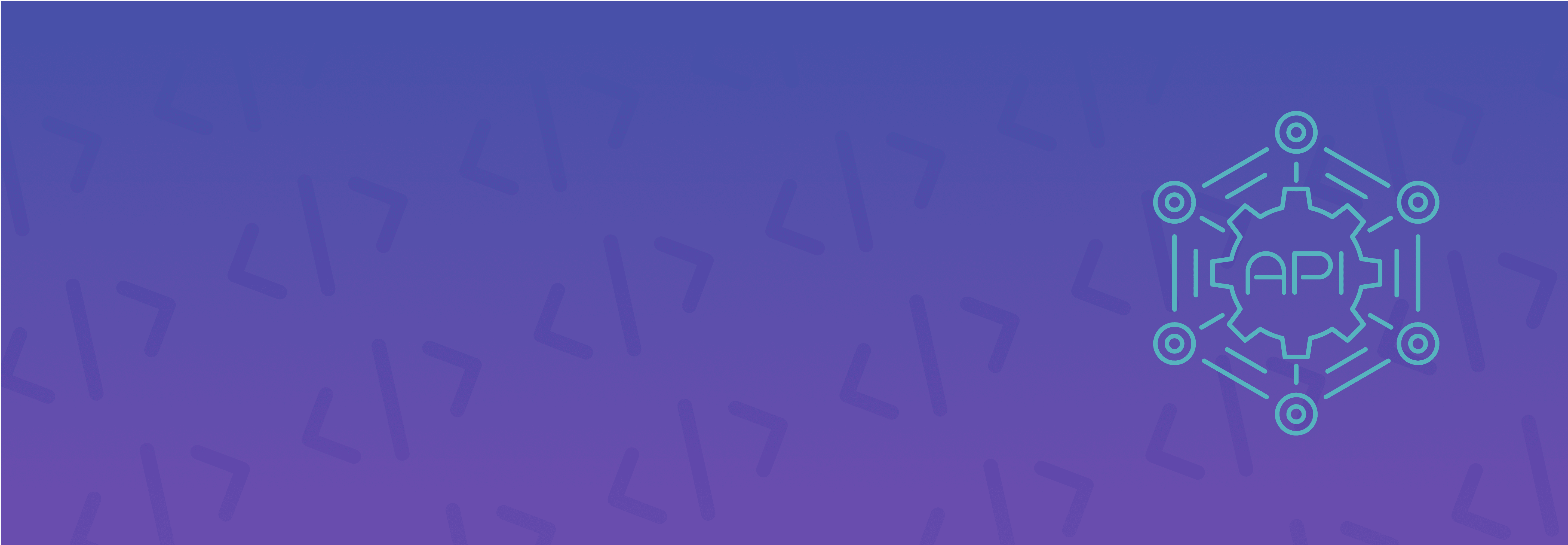Imagine, you’re designing a calculator for your project. You’ve added a beautiful design to the front end, with fancier function buttons than a regular calculator has, and added options for different themes.
Everything looks great, but now how will you execute if a user requests adding some numbers or a division?

This is where Compiler APIs come in. They allow you to use the real-time execution powers of an IDE in the backend of your application.
In this blog, we will cover everything you need to know about Compiler APIs and how to use them in your projects.
Let’s get started!
What is a Compiler API?
Compiler APIs (Application Programming Interfaces) are sets of tools, libraries, and protocols that enable developers to interact with compilers in real-time on the backend of their applications.
They enable developers to integrate a compiler’s functionality into apps, automate execution processes, and perform other tasks like code analysis, transformation, and generation.
Let’s understand this with an example.
Compiler APIs are like waiters at a restaurant. So, when you go to a restaurant you are given a set menu from which you choose the dish you would like to have and inform the waiter of your decision. In the case of an API, you request specific data or action from it that it retrieves for you.

Now the waiter takes your order to the kitchen, which serves as the server or the backend system. This is where the data you requested through the API is processed or stored.
Once your order is prepared, the waiter brings it to the table once it’s prepared in the kitchen. Similarly, the API returns a response back to the software or application that made the request. The serving of the dish is equal to a response in the digital world.
What are the different types of Compiler APIs?
There are a few different types of compilers available, so let’s take a look at those:
Rest APIs
An application programming interface following REST architecture’s fundamentals is known as a REST (Representational State Transfer) API. It offers a standardized means for software programs to interact with one another via the internet and carry out CRUD (Create, Read, Update, Delete) operations on data by using HTTP methods (such as GET, POST, PUT, and DELETE).
REST APIs rely on stateless communication, meaning that each client request contains all the information the server needs to understand and fulfill without relying on prior interactions. Typically, they represent data using lightweight data exchange formats like JSON or XML.
WebSocket APIs
WebSocket API is an advanced technology that allows a user’s browser and a server to establish a two-way interactive communication session. You can send messages to a server using this API, and instead of polling the server for a response, you can receive event-driven responses.
WebSocket APIs are commonly used in scenarios requiring real-time updates, such as live chat applications, online gaming, financial trading platforms, and collaborative document editing. This technology facilitates efficient and continuous data exchange between clients and servers, enabling rich and responsive user experiences on the web.
Why use Compiler APIs?
Whatever your use case and intended audience, the compiler engine will take care of the necessary tasks on your behalf. The compiler engine allows you to:
- Run and compile the code: The compiler engine offers the safest platform for code execution and makes it simple to implement.
- Write code in widely used programming languages: Compiler engines are compatible with all online compiler APIs for hiring and all compiler APIs for education. They can use any language they like to complete the compilation.
- Improve productivity: You may efficiently debug while defining and creating test cases.
- Save expenses: In addition to saving you time, the pricing is affordable.
- Save Time: Spend less on infrastructure and focus more of your time on the product and application at hand rather than wasting it on unimportant details.
- Improved instruction: Teachers can devote more time to each student thanks to remote compilation.
- Effective testing: You can design and develop your test cases for use in instruction or evaluation.
- API integration: You can make the apps you wish to use with our compiler APIs.
What does a Compiler API do?
A compiler API can do various tasks, as mentioned below:
Parsing Code
It can read and understand source code written in a specific programming language, breaking down the code into understandable elements (tokens) for further processing.
Code Analysis
Compiler APIs can analyze source code for errors, potential optimizations, or adherence to certain coding standards. This can help developers identify issues early in the development process.
Code Generation
They can be used to generate source code or intermediate code automatically based on certain inputs or templates. This is useful for building tools that generate boilerplate code, for example.
Compilation
It allows for the compilation of code into executable binaries or intermediate languages (like Java byte code or .NET IL) programmatically. This can be particularly useful for custom-build processes or integrated development environments (IDEs).
Code Transformation
Compiler APIs can modify existing source code, add new code, or perform refactorings programmatically. This can be used in tools that automatically upgrade code to use newer versions of a library or framework.
How does a Compiler API work?
There are multiple steps involved in the compilation process. In essence, the code goes through these steps one after the other. If there is a problem in the code, it is checked through these steps, and the compilation process halts in the middle and displays a compilation error. Otherwise, the compiler compiles the source code without displaying any errors. The following procedures are involved in the compilation process:
Lexical Analysis
The compiler’s lexer examines the source code first, dividing it into tokens like operators, punctuation, keywords, and identifiers. Like separating data on a spreadsheet.
Syntax Analysis
Syntax analysis is the next stage, in which the compiler/parser verifies that the code complies with the rules of the programming language and looks for syntax errors. The code’s structure is represented by an Abstract Syntax Tree (AST), which is created by the compiler. Like checking to see if your written essay has any grammatical errors.
Semantic Analysis
After the code is syntactically sound, the compiler parses the code and does semantic analysis to determine its meaning. Logical mistakes such as type mismatches, undeclared variables, and improper operator usage are checked for by the compiler.
Optimization
To enhance the performance of the generated code, the compiler may carry out several optimizations. It is a compiler phase that is optional. To improve program execution, it gets rid of unnecessary code and reorganizes the order of instructions.
Code Generation
Code generation is the final phase, in which the compiler converts the AST into machine-readable code. The code generator generates code in assembly language, which is subsequently converted into binary code that the computer can run.
How to Use a Compiler API: Step-by-Step Guide
Using a compiler API might sound daunting but it’s a simple process. There are a few prerequisites when it comes to using a Compiler API, where you must have API testing and development tools one easy choice is Postman. Once installed you can then get started with using compiler APIs in this way:
Go to JDoodle’s IDE
We are using the JDoodle IDE, which has a free Compiler API for all its users. An IDE that supports a vast array of programming languages and has easy debugging features is essential for making compiler APIs.
Write Down Your Code
Write the code of your choice or if you’re feeling stuck simply use the JDroid, JDoodle’s AI companion, to generate a code of your liking. Simply, type in a prompt, and your code will be generated in seconds.
In this example, we will use the Java IDE and the below code on simple addition:
Right-click and Go to Inspect
Once your code is written, select ‘Inspect’ from the drop-down menu.

Click On Network
Once the Inspect slide opens on the right side of your screen, click on the ‘Network’ option from the menu that appears at the top of the right side and then click on ‘Fetch/XHR’.
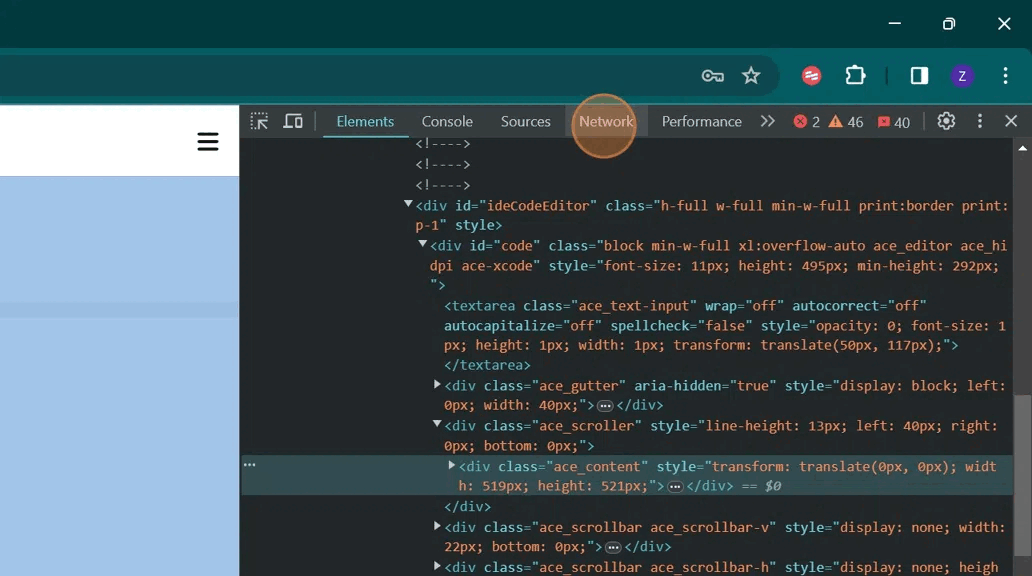
Press Execute
After you’re in the network tab, execute your code. An execute function will show up in the network tab. Right-click on the execute function and click on either “copy curl” or “copy curl (bash)”. Selecting anything else can cause errors.
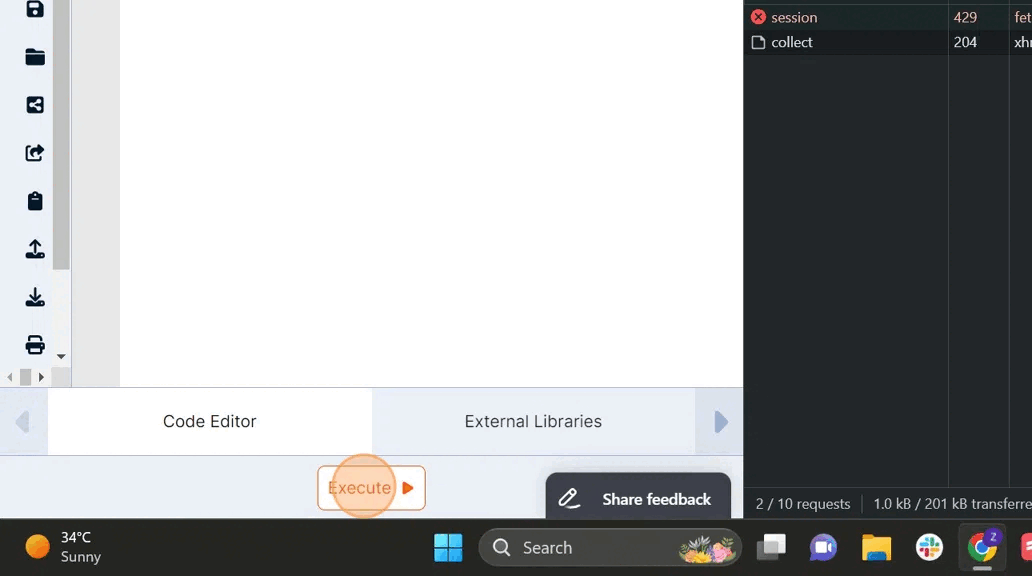
For the above Java program example, this is the code you will get for importing to Postman. You can directly import this code and try it out:
curl 'https://www.jdoodle.com/engine/execute' \
-H 'authority: www.jdoodle.com' \
-H 'accept: application/json, text/plain, */*' \
-H 'accept-language: en-GB,en-US;q=0.9,en;q=0.8' \
-H 'cache-control: no-cache' \
-H 'content-type: application/json' \
-H 'cookie: _ga=GA1.1.1836523536.1698935797; mf_user=0d87b3960e57c88c1305b6b0a965d63b|;
mf_07ad8e83-73c2-4dff-801c-b6a87bb2a174=9a851c5ee817e8221ae3e631fedd0f18|
01040122bfe242fb3023bc2a146e619e2b32d15c.1023831423.1704338461228$
01040305a20b2e5da663b6979747bd6bebc1c487.-4417060397.1704338463314$
01040324c85d52c9e7c7096d5e76c1754d2e1d19.1050412422.1704346833354$
01043954f445a8aeab4ee2a6e1a302309a4a4cc7.1050412422.1704387699257$
010445427c6d12206b1549b298ae34b492b048f6.1023831423.1704387705343|
1704346855607||1||||0|17.97|78.70841;
_omappvp=TkfBPkoH0My2UpsrSI95AdvgU2v3xBzFJrpDj0BwjdZEy0vDlb375IpWEmo0j3q2I0W5z9iyCVdXijwG6nE8rEoQLn1wCg36;
__stripe_mid=fac3ff48-ff5e-405b-ba89-03ba44b1758461c209; _ga_Z3GW0401P2=deleted;
g_state={"i_l":4,"i_p":1710734761425}; __cuid=d415506d2047416b97498dff657fc8bf;
amp_fef1e8=a0408eeb-f0cb-4e13-83f1-4c84e16a585bR...1hoed17db.1hoed1le8.2n.8.2v;
marker_id_65379a42896b9b3785d33e92=876ec352-4d0e-40f6-9819-3903f1b91de7;
SESSION=0277f160-aa1d-460a-80f3-020c7f7ebaa9; _clck=6lrkcf%7C2%7Cfk2%7C0%7C1477;
_clsk=x7qh9z%7C1710377534239%7C13%7C1%7Ca.clarity.ms%2Fcollect;
_ga_Z3GW0401P2=GS1.1.1710376931.310.1.1710377542.0.0.0' \
-H 'kurukku-kuri: be49c57b-0abb-4c6c-9008-878860eb4283' \
-H 'origin: https://www.jdoodle.com' \
-H 'pragma: no-cache' \
-H 'referer: https://www.jdoodle.com/online-java-compiler' \
-H 'sec-ch-ua: "Chromium";v="122", "Not(A:Brand";v="24", "Google Chrome";v="122"' \
-H 'sec-ch-ua-mobile: ?0' \
-H 'sec-ch-ua-platform: "Windows"' \
-H 'sec-fetch-dest: empty' \
-H 'sec-fetch-mode: cors' \
-H 'sec-fetch-site: same-origin' \
-H 'user-agent: Mozilla/5.0 (Windows NT 10.0; Win64; x64) AppleWebKit/537.36
(KHTML, like Gecko) Chrome/122.0.0.0 Safari/537.36' \
--data-raw '{"script":"public class MyClass {\n public static void main(String args[]) {
\n int x=10;\n int y=25;\n int z=x+y;\n\n
System.out.println(\"Sum of x+y = \" + z);\n }\n}",
"args":"","stdin":"","language":"java","versionIndex":5,"libs":[],
"projectKey":1001,"hasInputFiles":false}'
Open Postman and Import
Now open Postman and click on the import option that appears on the topmost menu on Postman.
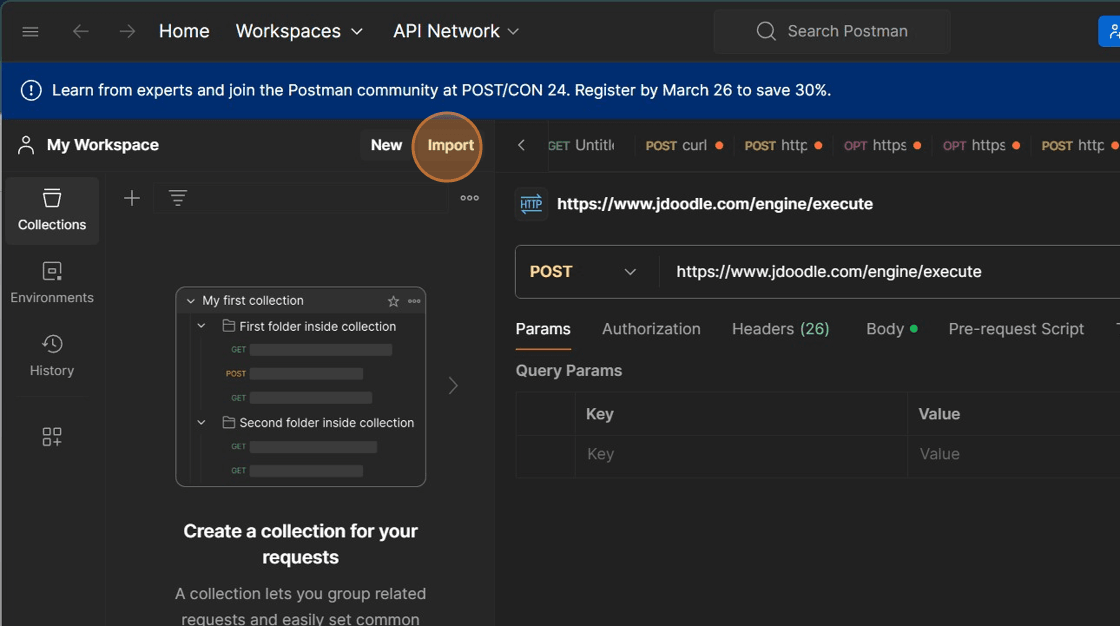
Paste your URL
Now simply paste your copied cURL(bash) URL that you had copied earlier and press ‘Send’
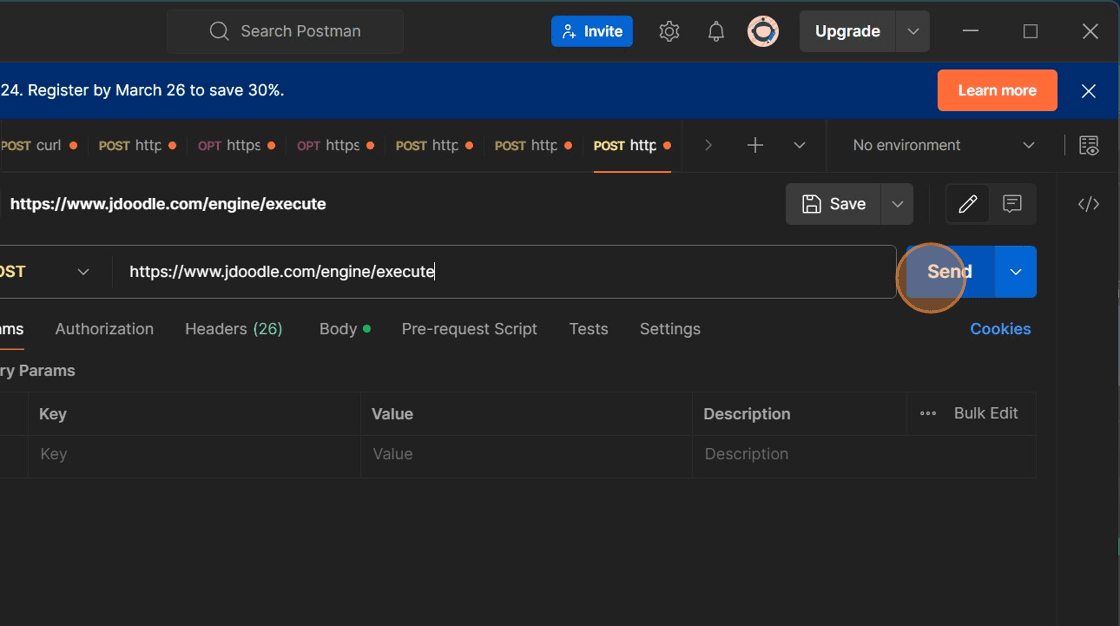
That’s it! You have now successfully learned how to use a compiler API.
To understand and learn more about JDoodle’s Compiler APIs, you can refer to our documentation.
What are the Use Cases of Compiler APIs?
Compiler engines and online compiler APIs have a wide range of applications given their functionality:
Massive Open Online Courses (MOOCs)
Students can learn several programming languages from several websites and portals. Students are given a variety of engaging assessments to evaluate their skills. They typically use compilers that let the students complete the assessments on the platform itself, making them entertaining in addition to instructive. These exams help in evaluating students’ programming skills and provide them with current data in real-time.
Training Programs
A compiler engine can be used to teach students who are new or who wish to improve their abilities. This application of knowledge is important for mental development. Compiler engines produce detailed reports with everything from execution time to faults to maintain track.
Recruitment Platforms
Since technical recruitment, in particular, requires evaluating candidates’ coding abilities, you can utilize the compiler engine in addition to your recruitment software to obtain a secure platform for recruiting which guarantees a positive candidate experience.
Code Generation
Compiler APIs are employed in code generation frameworks to automate the creation of repetitive or boilerplate code. This can include generating serialization/deserialization routines, database access layers, or even entire applications from high-level specifications
Performance Optimization
Compiler APIs are used to develop tools for optimizing code performance. These tools may analyze code to identify performance bottlenecks, suggest optimizations, or automatically apply optimizations such as loop unrolling, inlining, or vectorization.
Power Up with Real-Time Execution using JDoodle Compiler API
After learning more about what a compiler is, allow us to present to you the all-in-one compiler. There are a tonne of features packed inside the JDoodle compiler.
Supercharged with the power of two of the most robust APIs; Restful API and WebSocket API, they’re designed to make your applications powerful and engaging.
So, if you’re searching for the ideal compiler API, look no further than JDoodle. But we still haven’t told you the best part, JDoodle offers all its users 200 FREE API credits daily!
So, why the wait? Try out our compiler APIs and become a JDoodler today!
Frequently Asked Questions (FAQs)
1. What is Java compiler API?
The Java compiler framework is represented by javax.tools, serves as both an Application Program Interface (API) for executing compilers and other tools, and a Service Provider Interface (SPI) for tailoring specific aspects of a compiler to suit particular needs.
2. What is API used for?
Application programming interface, or API for short, is a software bridge that enables communication between two applications. Data extraction and sharing within and between companies can be done effortlessly through APIs.
3.Who uses API?
In today’s day and age, many sectors use API including E-commerce, healthcare, government, manufacturing, and financial services.
4.Who invented API?
British computer scientists David Wheeler and Maurice Wilkes had been developing a modular software library for the von Neumann-based EDSAC computer in the 1940s. They produced what is now known as the initial API documentation throughout this process.

